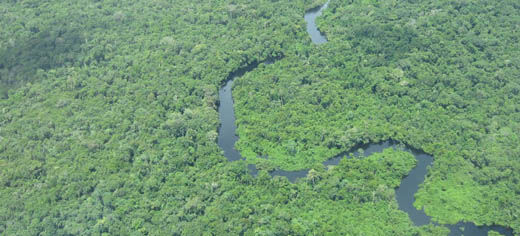
The highest concentration of carbon in parts of Amazonia is not stored in trees, but below the ground as peat, according to new University of Leeds research.
Mapping and quantifying carbon stored in the largest area of peatland forest in Amazonia, a geological basin almost the size of England, the researchers estimated that more than three billion tonnes of carbon is stored within this ecosystem.
While Amazonian forests are known to harbour large stores of carbon in their trees, the findings revealed that 90% of carbon in this area is actually stored below the ground as peat.
The researchers now say that by understanding where the carbon is stored, policies can be developed to protect these ecosystems and play an important part in helping reduce carbon emissions.
Lead author Freddie Draper, a PhD student at the University of Leeds, explained the mapping process. He said: “Combining satellite data with extensive field data, we have been able to provide spatially explicit estimates of the amount of carbon stored in these ecosystems for the first time.
“Ordinarily in tropical forests, the vast majority of carbon is emitted back to the atmosphere as carbon dioxide, as trees die and decompose. However, waterlogging in peatlands means that decomposition is very slow so the carbon accumulates as peat.”
Co-author Dr Tim Baker, Associate Professor from the School of Geography at the University of Leeds, presented the results to policymakers at Voices for Climate on the margins of the recent UN Climate Change Conference COP20 in Lima, Peru.
He said: “Mapping and quantifying the amount of carbon stored in these ecosystems is an important part of prioritising national strategies to mitigate climate change. For example, these peatlands occupy just 3% of the forested area of Peru, but contain almost 50% of the total amount of carbon stored above the ground in all Peruvian forests”.
The international team of researchers included experts from the Universities of St Andrews, Edinburgh, and Turku in Finland, in collaboration with the Research Institute of the Peruvian Amazon (IIAP).
Co-author Katherine Roucoux, from the University of St Andrews, added: “The peatlands we studied are largely intact, in contrast to tropical peatlands in South East Asia that have been exposed to decades of destruction, leading to huge carbon emissions and biodiversity losses.
“However, most of the peatland area, including the most carbon-dense peatland type, currently lies outside of the protected areas and threats are increasing. If these carbon-rich forests could be protected too, then large emissions of carbon to the atmosphere could be prevented.”
The research was funded by the Natural Environment Research Council (NERC) and published in the journal Environmental Research Letters.
For further information
Contact the University of Leeds press office on pressoffice@leeds.ac.uk or email pressoffice@leeds.ac.uk
Read the full paper here: http://iopscience.iop.org/1748-9326/9/12/124017